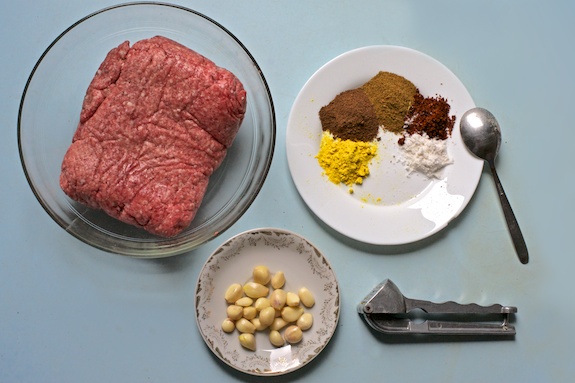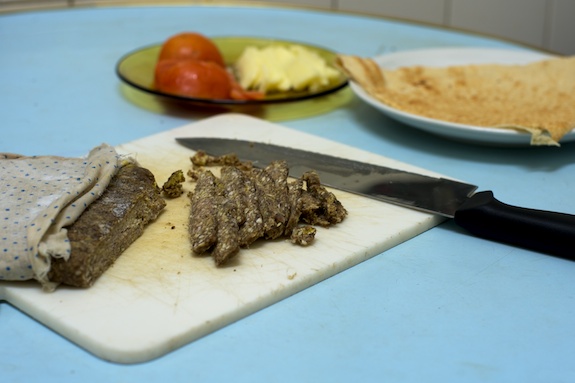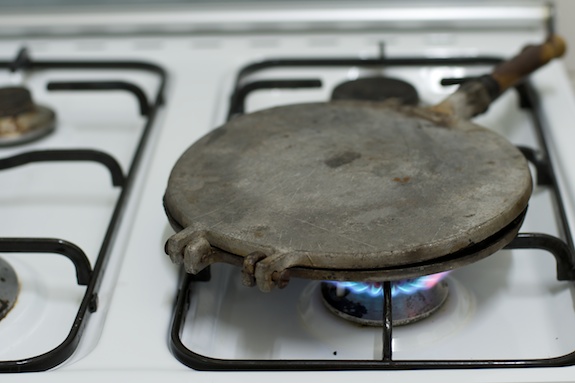There is something about making a dish completely from scratch that is wonderfully satisfying — a feeling of merited accomplishment. A mixture of happiness and relief. I’m sure this is true of most things, really, not just food. It comes with any craft you can pour your soul into. With food, you appreciate individual ingredients; you savor every ounce of effort that goes into preparing a dish. Something magical happens in the cooking process; a part of you, your essence, probably while you’re mixing ingredients and not particularly paying attention, dives into the bowl and adds that special something to the dish: warmth, brightness, love, something you can’t really put your finger on, but everyone knows it’s there.
In Syria, particularly Aleppo, wintertime means it’s time for sujuk, an Armenian sausage made with beef, lots of garlic and a mix of aromatic spices. Sujuk is bold; it’s a stick-to-your-ribs kind of sausage. And when it gets cold out, it’s what my heart and stomach crave. Yes, sujuk is pretty fantastic.
In Aleppo you can find sujuk all over the place. This is one of the culinary gems the Armenian community brought with them when they moved to Syria. One of my favorite places to eat sujuk outside of home is Shtoura. Shtoura, named after the Lebanese town, is a 24-hour fatayer place famous for their heavenly dough creations. I’m a regular there.

Nothing is better late at night than a couple Shtoura palm-sized pizzas topped with classic tomato sauce, liberal amounts of shredded mozzarella, and dotted with nuggets of spicy sujuk.

My aunt, luckily for me, makes her own sujuk at home. And to my surprise, it’s pretty simple, and actually borders on effortless. It’s a matter of combining a blend of spices with meat and allowing the mixture to air-dry in a cool place, away from any sunlight. Prep-time is no more than 15 minutes, tops. No sausage casings or fancy equipment necessary; my aunt stitches her own bags from scraps of cloth that are clean and have not been treated with scented detergent.



After asking a few of my Armenian friends in Aleppo, I’ve discovered that it is not common to add ground fenugreek to sujuk. If you can’t find fenugreek, you can certainly leave it out, however, I like the taste it adds to the sausage.


My aunt uses her balcony to air-dry her sujuk. She moves the rack of sujuk bags depending on the time of day to keep them away from any sunlight. Once the bags feel firm and dry to the touch, the sujuk is ready. This usually takes 3-5 days depending on the weather and the thickness of your sujuk bags.
Once they’re done drying, my aunt and I keep all the bags, except one, in the freezer and bring them down to the fridge as we go through them.

Sujuk is an extremely versatile sausage that you can eat any number of ways. It’s great over pizza or mixed into pasta sauce. It’s delicious with eggs for breakfast — a different take on the classic sausage and eggs. In Syria and Lebanon, however, it’s popular to make sujuk sandwiches with pita bread. The grease from the sausage melts over the heat and toasts the bread to a pleasant crisp. No extra butter or fat necessary — just good, homemade sujuk.



Sujuk Sausage
yields approx 1kg
Components
- 1kg ground beef, freshly ground
- 1/4 cup garlic, minced
- 2 Tbsp cumin, ground
- 2 Tbsp allspice, ground
- 1 1/2 Tbsp fenugreek (optional), ground
- 1 1/2 Tbsp Aleppo pepper
- 1 Tbsp kosher salt
Putting them all together
- Mix all the ingredients together and refrigerate overnight.
- Stuff meat mixture into clean, porous stockings and let hang for 3-5 days in a cool, dry place away from any sunlight.
- Once pouches are dry and firm to the touch, remove from the hanging rod and store in the refrigerator — leftover pouches keep great in the freezer.
Notes:Make sure whatever you use to encase the meat is clean, but more importantly make sure it does not have any detergent scent. Sujok keeps great in the freezer. I bring down a pouch at a time from the freezer to the refrigerator as I go through it.
20 yrs ago I discovered a very good Syrian restaurant in Montréal and they had a delicious sausage on their menu. I wonder if the spices they are using are the same as in your sausage. Sounds really good on pizza.
Tony, this sounds and looks lovely. Thanks for sharing with us!
We call them Toshka at home. I never knew they were Armenian!
And that looks so tasty, I’m so hungry right now.
You’re posts are not good for the hungry!
Delicious post! 😀
Helene, the spices are pretty standard except for the ground fenugreek, which some people choose not to add. Otherwise, it should come pretty close.
Thanks, Alta! Glad you liked it 🙂
Hi, A. Some places here in Aleppo also call it Toshka, too. Sujuk has become popular all over the Middle East now. It’s hard to say where exactly the dish came from, but from what I read, it was introduced to Syria (and the Levant in general) by the Armenian community.
Kudos for making your sausage from scratch. I have yet to do that. It looks delicious!
Nisrine
This is great. Reminds me of نقانق حلبي that my dad makes, except he hates garlic (and by association I do too).
Can you post more YouTube videos involving Arabic conversation? I really enjoyed them (food and languages are my weakness). Thanks and good luck with your research.
Thanks Tony: my wife loves نقانق حلبي ; it is her all time favorite food, I am concerned with letting the raw meat to dry outside (Health wise and we live next to a park (lots of animal), I am wondering if we dry it in the fridge (not the freezer) will work.
Thanks
Zach: will try to post more videos soon 🙂 I have lots of videos but since I don’t have high-speed internet, it’s not always easy to get them online. I will go to an internet café soon to try and load new videos.
Gassan, that’s a legitimate concern. I worry, however, that if you hang your meat in the fridge, your fridge will develop strong aromas from all the garlic and spices. I found this article that talks about hacking your freezer to dry cure sausage — personally, I think it sounds like a lot of work.
Once I get back to the States, I plan on building a simple cage with a wooden frame and stapling insect screen on all sides. This should address any insect or animal concerns since I also have lots of greenery around where I live. With regards to the temperature, this should only be done in the fall/winter when the weather is relatively cool (40-50 degrees F). If you use the freshest meat possible, keep it away from any direct sunlight, and use enough salt, you should be fine. I hope this helps…
Hi Tony,
Thank you for this yummy post. I have just moved to NoVA from Texas and was wondering if you know of turkish/armenian restaurants/grocery stores that would sell authentic basterma and sujuk in or around DC. I have had outstanding basterma a couple of years ago at Jose Andres’ Zaytinya’s. It tasted exactly like what I used to eat as a child at our neighborhood’s armenian restaurant in beirut.
Thanks!
That looks wonderful! I’d like to try making my own sausage, but it’ll have to wait until the weather gets above freezing. Great job! It looks wonderful! 🙂
Tony, you are a live saver. As a middle-eastern immigrant to the States, I often suffered the lack of availability, or the very high price of Sujuk. I have tried your recipe, and to my surprise, it tasted just like the Sujuk I used to buy in Lebanon, Borj Hammoud, an Armenian town. Now I make for me and share with friends for the price of ground beef and a little effort. You are a live and money saver, and I thank you for that.
thanks tony for posting this recepie it looks good. im just wondering does the weather have to dry? and what kind of bag can i use
Thank you Ghassan; sujuk is usually prepared in late fall and throughout winter in Aleppo. Most importantly, the weather should be cool outside to avoid the meat from spoiling. Choose a location that is cool and receives a lot of ventilation (the air/ventilation will help dry the sujuk). Any porous cloth should work as a bag — a lot of families sew their own “bags” made out of leftover cotton fabric. Make sure that whatever cloth you use is clean and does not have any detergent scent. I hope this helps.
Tony, I go to a Lebanese restaurant in Saint Louis MO, where Sujuk and Maqaneq sandwiches are made from fresh ground beef without drying or encasing. The restaurant uses a recipe with lots of crushed hot paper. The taste and aroma are so satisfying and superior to any Sujuk sandwich in Bourj Hamoud. Do you know what kind of spice brings the distinct aroma in the Sujuk? Have you tried ground garlic in lieu of fresh garlic? Thanks
Hi Michael, thanks for the comment. Can you please tell me the name of the restaurant in Saint Louis? I have a friend who lives in MO who I’m sure would love to go there.
I have had non-dried sujuk a couple of times. The only problem is that it doesn’t last for long in the refrigerator — a few days top. Non-dried sujuk works in a restaurant setting where they can go through a lot before any of it goes bad. The recipe I posted should also work for non-dried sujuk: I would recommend refrigerating the sujuk for a few hours (preferably overnight), covered, so that the flavor and oils of the spices mix well with the meat. I have not tried dried garlic instead of fresh, but that should work just fine. Be sure to use a less dried garlic than you would fresh since the flavor will be concentrated (this is true of all dried spices). Sahten!
Hello Tony. I just did a search for sujuk flavoring and looking at the photographs in your blog, took me back home 30 years ago, when my mother did exactly what you show. She even made Basturma and wrapped it, and hung it the same way.
As a chef now I have in immense curiosity to understand food and culture as one. So, I have a question. The sujuk I have always had, home-made or store bought, has a little acidity to it. Does it acquire the acidity from the fermentation during drying? Or does it have a minimal amount of some type of acid such as citric acid added. Mind you, I actually like the subtle acidity; I am just curious. I am going to try your recipe and taste it fresh and dry to compare the acidity.
Thanks for the recipe and the memories and I am looking forward to your reply.
Thank you for the nice detailed post of sujuk pictures they are nice . I hope you dont mind. i saved some of the picures they are really nice thanks again
Hi Tony,
Great recipe ,thank you.Just one thing , people should wear plastic gloves when handling fenugreek.I was not aware it is what you call Chaman in Arabic ,and had to cope with the aroma on my hands for a couple of days -))
I did not know that feugreek is used in Sujuk ! though I know it is the vital ingredient when you make Basturma.
Keep the good work.
Fenegreek is basic in Egyptian “Sujuk”, especially “Pastrami”, mixed with garlic and paprica and touch of salt. In Pastrami, you add drops of water to form a “paste”, then cover all surface of the raw eye of round beef with about one or two millimeter thick.. as for fear of contamination, in “ALL” cases of eating sujuk or pastrami they shouldn’t be eaten raw in ANY CASE, they have to be well cooked or fried now that lots of bacterial contaminants are to be a concern nowadays, not only that, utensils, hands, cutting boards and anything that comes in toutch with raw meat have to be sterilized, too bad for the fellow who hates the smell of bleach because it’s the best sterilizer along with detergent.
I was born in Borj Hammoud, I spoke Armenian for a long time. The best Sujuk ever made by Armenian, but it is of a reddish color. May be the Paprika does it?, but your doesn’t have the same color. Medo I Borj hammoud now is the best. Thanks for posting, i’ll try it.
The acidity and red color are from the spice Sumac I think.
Thank you, making soujouk from scratch is the only way it tastes right. Store-bought never lives up to it. I am really pleased at how easy and successful it was.
One question: has anyone had success with a less-fuzzy cloth? I had to pick a lot of cotton of my soujouk. I know muslin is preferred for bastegh. Perhaps for soujouk as well?
@Pete, I agree, homemade is the way to go! I’ve never tried using a muslin bag to cure meats, but that’s not to say it wouldn’t work. The key is to ensure there’s proper ventilation so that the meat can at air dry. If there is no ventilation, you also run the risk of creating an anaerobic environment perfect for botulism.
You might also try using a cheesecloth. I haven’t tried this myself, but I don’t see why it wouldn’t work.
I hope this helps!
Tony,
Thanks for a great recipe! I for one love Sumac, how much would you (or anyone) add to your recipe if you elect to use it?
Guys, Sucuk (Sujuk) is originally Turkish. The recipe told here is the Amenian version of it, where Bulgarians, Central Asian people have their own versions.
Oh my, that looks so good! Only I’m wondering why you left out the sumac, doesn’t it belong in there?
@Nihal: I haven’t heard of adding sumac to sujuk before. A couple people mentioned sumac in the comments, so perhaps it is a regional variety that I haven’t heard of? I know some Armenians like to add ground coriander to their sujuk, too, which I didn’t add to mine. Thanks for sharing!
Thanks ,
no red wine in the recipe?
@Josephine: I don’t add any wine to mine. I seem to recall a Lebanese version that calls for red wine, but I’m not positive. This variation is all about the spices.
Hi Tony, I have just discovered your blog and find it very interesting, I have been experimenting with making busterma , my parents emigrated from Aleppo in the early 20’s. My mother made busterma ( we called it adeed) I found some recipes ,printed and by word of mouth from various books and old timers, unfortunately my parents passed years ago so I wasn’t able to get a specific recipe from them.I have made a few batches in the past month and I must say they tasted very good, as good as the commercially made busterma.I purchased a cut of top round beef about the size of a large hand and about 1 1/2 inches thick weighing about 1 lb..I pierced it with a fork all around and coated it with kosher salt and pressed it With a weight for 3 days in the fridge, I then put in a string to hang it after washing off the salt and drying the meat. I then made a coating mixture of fenugreek, paprika, red cayenne pepper , fresh pressed garlic, and pepper.and water to make the paste. I covered the entire piece of meat completely , no openings
This seals the meat and cures the meat. I then hung it in the fridge for 10 days. It is now ready to eat, I enjoy putting it in a pita bread or frying it with eggs.
1/8 cup of fenugreek
3tspoons paprika
1 t sp cayenne pepper
1tbl sp black pepper
10 garlic cloves puréed
1/2 cup cold water
many thanks
Tony…My grandfather, father and uncles who descended from Syria (Aleppo) all made a dried and cured lamb that they called a’deed. My cousin and I are doing a Syrian cookbook of his mother’s recipes and we have a recipe for a’deed but can not find anything that calls it a’deed. I was wondering if you have reference to the term a’deed.
Cut meat into 4–5 pieces. Generously season with salt on each side. Put in a bowl with a paper towel on bottom to absorb moisture which will form. Cover and leave in the refrigerator overnight. The next day, string each piece of meat and hang outside on a pole somewhere safe from pests for 1–3 days until the meat starts to feel dry (firm) to the touch. Peel the garlic and crush. Mix together with the rest of the ingredients. Add more water if needed to make a paste and coat the meat with the paste. Put the meat back outside for 2–3 days to cure.
Hi Basil! “a’deed” (قديد) is a common name for “basterma” in Aleppo. It’s a general term for dried meat. It comes from the verb قدد (pronounced qad-da-da), which means to dry. I documented the process for making a’deed/basterma on my Facebook page. I hope this helps with your research! Let me know if you have any other questions. I’d be glad to help 🙂
Hi
I really would like to learn how to make sujuk 😍
I ben eating real arminyan Soujuck for al my life first thing when i arrive home(old country) i go to our old friend vikin (real Arminyan )
he had a restaurant down town…. all what he makes sujuck,spleen and liver sandwiches sujuck has a special taste a little bit sour like if you added lemon to it i asked my good friend about that good taste … you know guys what it is it is an Arabic spice grows only the middel east the name is(((Summaak )) this what make the different between Arminyan Sujuck
and a copy the clove and the garlic and the Summaak also one other thing no lean meat 30 to 40 % of sujuck must be the fat
they never through away that good fat around the kidney all the fat inside the cow is used they can’t afford to through any thing ,,,,that why it is a good food for winter i consider it one of the best Mediterranean delicateness
Hi Tony, thank you for posting recipe of Armenian Sausages from scratch. I’m from an Egyptian background but grew up in Africa. There were lots of Aremians that live there where they were escaping from all the unhumantarian conducts that they encountered. Accordingly and luckily for us, they introduced lots of their authentic delicacies such as Sujuk, Basterma, Mortadella, Feta Cheese, Hard Romanian Cheese, Braided Mozzerela Cheese, etc.
Sujuk in particular was a kind of little sausages stuffed in lamb casings, and they had no garlic or feungreek. Other than that it contains all the other spices such as nutmeg, allspice, cloves, vinegar, and some add bread crumbs to the meat to tenderize the bite.
What I noticed Tony, some of the original receipes get shifted around according to the ingrediants that are available in the regions and to the liking of the locals. Having said that Sujuk remains an Armenian dish and everyone should keep this name so we learn about the origin of different dishes.
Cheers,
Nuha Azir
Tony, my mom has been dead since I was 20. I used to wing the recipes in hopes of getting the tastes of her food ( she was Armenian from Halab). Since discovering your website ages ago you’re my go to. Your grandmothers recipes are my moms. Love them all and if ever I’m asked about a recipe I always direct them to your website. Thanks